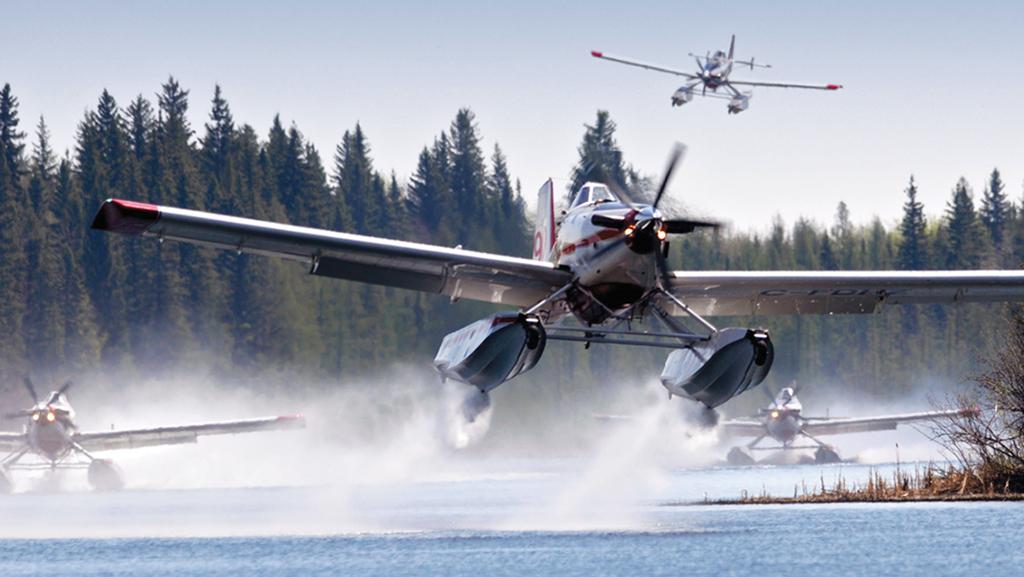
A legend in the agricultural aviation community, Leland Snow created the first purpose-built aerial spray aircraft as a college student in 1951. He went on to found two “agplane” manufacturing companies, both based in Olney, Texas. The first, Snow Aeronautical, he sold; the second, Air Tractor, produces a range of single-engine models that are ag-av mainstays.
Notably, in the late 1980s, he focused on an entirely different application: dousing wildfires. Although Canadair had been producing a twin-engine water scooper/bomber, aerial firefighting primarily involved former military and transport aircraft fitted with water/retardant tanks and dispersal systems. Snow thought a single-engine machine designed for the purpose would be more effective.
After years of design, refinement and testing, a certificated AT-802 firefighter emerged in 1993. The beefy aircraft featured an 800-gal. tank, 16,000-lb. takeoff weight (more than half being useful load), unrefueled endurance of 4 hr., computerized dispersal system and a PT-6A turboprop up front. At the time, Snow, who died in 2011, commented, “We’ll probably build 10 or 12 of these.” Not all visionaries see the future clearly all the time.
Soon, Snow’s traditional customers wanted the big airframe adapted for ag work, and he complied. Later it was also adapted for oil spill cleanup and other roles including militarized versions acquired by the U.S. Air Force for commando support. This past January, Air Tractor delivered the 1,000th AT-802, including some 280 firefighters.
Air Tractor’s firefighter had been in production for less than a decade when Snow was approached by Bob Wiplinger, then-CEO of Wipaire, the Minnesota-based aircraft float-maker. He proposed fitting the AT-802F with amphibious floats, enabling it to skim and scoop water, fill its tank in seconds and return to the fire. Snow expressed doubt about the conversion’s viability but wished Wiplinger good luck. Visionary myopia once again.
Wipaire proceeded alone and in 2003 received a supplemental type certificate for an AT-802F scooper it branded the “Fire Boss.” Since then, the company reports more than 140 aircraft have undergone the conversion—and with a backlog exceeding 20, the challenge is satisfying demand.
In combating wildfires, the AT-802F and Fire Boss are employed primarily as initial-attack aircraft. Given plentiful fuel, heat and accommodating wind, a fire can spread alarmingly fast. An immediate and overwhelming response is key to halting its progress.
Because it readily operates out of short, forward strips and can conduct multiple attacks in minutes, Air Tractor’s firefighter is well suited for the role. And Fire Boss backers note that since blazes often begin near scoopable water, their aircraft can fill and dump quickly for hours. Moreover, the AT-802F’s relatively low base price of approximately $2.8 million—add another $1.5 million for the Fire Boss conversion—means some operators can field small squadrons that can douse flames in steady sequence.
The Conair Group is a major aerial firefighting outfit and Air Tractor dealer headquartered in Abbotsford, British Columbia, with subsidiary operations in the U.S. and France. Its fleet of 70 aircraft includes multi-engine air tankers and scoopers, fire control singles and, notably, 22 wheeled and float-equipped AT-802s. While each aircraft contributes to the firefight, Jeff Berry, a Conair vice president and wildfire expert, lauds the Air Tractors’ reliability, short-runway capability and cost-effectiveness. Moreover, they “pack a pretty good wallop in either configuration,” he says, adding that Conair has more on order.
Meanwhile, Dauntless Air of Appleton, Minnesota, operates 17 Fire Bosses, the largest fleet in the U.S. CEO Brett L’Esperance cites the aircraft’s robustness for helping his team maintain fleet availability of 99.3%. Furthermore, he notes, equipped with head-up displays and infrared capability, their pilots can target hot spots within the thickest smoke, thereby providing extra protection for ground firefighters. He also praises his aircraft’s operational efficiency, citing a $0.67 per gallon delivery average versus other firefighting aircraft, whose drop costs can be double that or far more.
Berry and L’Esperance agree that wildfires are a global, year-round threat and growing. In the U.S., L’Esperance notes, acreage lost to fire has doubled from the average of 3.5 million acres per year from 1980 to 2000. This year, Berry notes, hundreds of persistent wildfires stretched coast-to-coast across Canada, which is rare.
It appears Leland Snow saw clearly through the future miasma after all.
William Garvey was editor-in-chief of Business & Commercial Aviation from 2000 to 2020.
Editor's note: This article was updated to correct the AT-802 price and include information about the number of AT-802 firefighters delivered.

